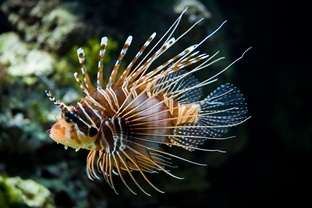Posts Tagged: protection
Succulent Boxes
In 2012, the Solano Master Gardeners held a class to make succulent boxes. We brought succulents from home and planted them in pre-made wooded boxes. The boxes had been constructed by volunteer Master Gardeners (or their husbands) who were gifted with building skills. The boxes were 6x6x3.5 inches, had a hardboard backing and ½ inch wire mesh on top. Everyone attending filled their boxes with soil, shared succulents and inserted them into the small spaces in the wire mesh. The group was loud and excited. It was a fun-filled, sharing, learning experience.
I came home so excited and mentioned to my husband that I wanted to make another succulent box BUT on a grander scale. Being the inventive and frugal person he is, he found a picture frame our neighbor had thrown in the trash, discovered some left over cement board in our garage and a yellowed piece of plastic lathe that was left over from building our patio. With those materials and a few screws, he created a succulent wall planter, 16x30x3 inches. He spray painted it ‘John Deere’ green so it would blend into the garden. It took awhile to fill each small opening in the lathe with the succulent cuttings I had been snipping from our garden. He placed two eye-hooks on each end of the box and hung it from the fence where two eye-bolts had been placed. This system makes rotating the box simple and keeps the soil inside from ‘slumping’. The first of each month, the box is taken down, placed across the top of our wheel barrow and watered thoroughly. We leave it flat for approximately an hour for the water to saturate the soil. Then it is hung in the opposite direction (using the eye-hooks on the opposite end).
This large succulent wall survived the winter with some minor frost damage. I did not cover it or provide protection last winter. This winter I plan to protect it with frost cloth or move the box into the garage. The frost damaged succulents were removed and NOT replaced. The plants not damaged have grown significantly and now cover the empty holes in the lathe.
The box has turned into a traveling planter, being a display item at the Dixon May Fair. When it returned home, it was not placed in the initial hanging spot. It presently hangs against the garden cottage wall next to the covered patio. It makes quite a statement as you walk down the brick pathway to enter the backyard garden.
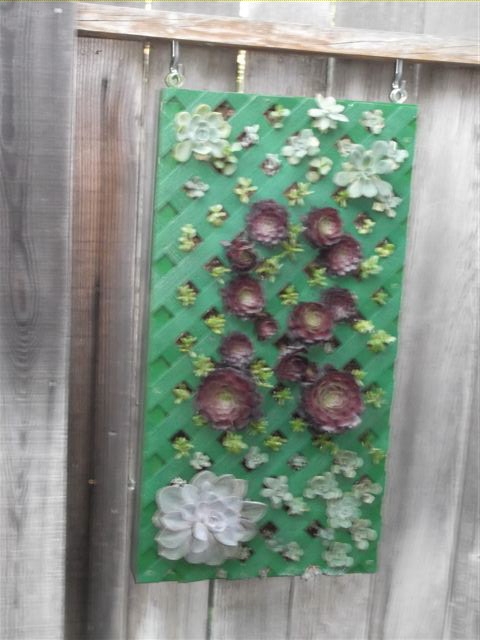
Sorry, picture a little blurry, but it's the start of the succulent box. (photos by Sharon Rico)
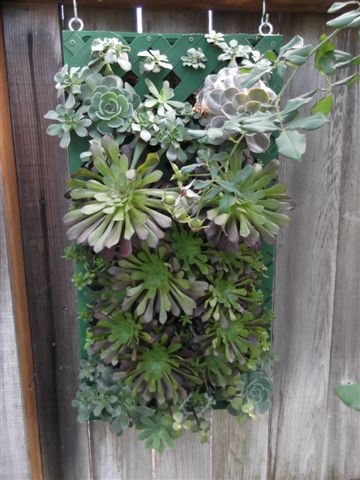
Succulents maturing in the box.
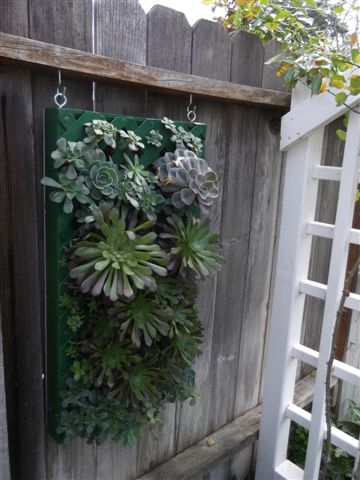
The final product is pretty nice.
Sorry Ladies!
Back in February, I wrote a blog that was a bit of a love letter to our three hens. Today we planted our tomatoes, so the love story has, sadly, come to a screeching halt.
This year’s tomatoes went into one of two raised beds, which have sat fallow for two years. I have always had to create a “dome of protection” with bird netting over the raised beds, as they abut a large open space where coveys of hungry quail lurk. And now we have to worry about our hens raiding the garden boxes, too.
Bird netting is hateful stuff. It catches on everything — branches, leaves, earrings, eyelashes. We wanted to make our lives easier, when it comes to bird netting, by building semi-permanent frames onto which we could wrap netting. I found a thorough online description for building PVC frames, and the construction began.
Our two raised beds are 4 feet by 10 feet. We started out making one rectangular frame to fit over the top of the beds. This was unwieldy to build, and would be too heavy and wobbly to move out of the way for harvesting and such. My husband decided to construct two frames, 4 feet by 5 feet each, and they went together much more easily. The beauty of two frames is they’re light. I can raise one half of the cover to harvest, add mulch or pull weeds. Knowing how tall indeterminate tomatoes can become, we plan to make two more frames that will stand taller. For now, the 3-foot height is fine.
Our hens are a bit miffed. They saw us put in the tomato seedlings this morning, and rushed over to gobble up those sweet new leaves. After much shooing and distracting with fresh, wormy piles of compost thrown their way, my husband and I were able to cover our new plants with our new frames. I’ll keep you posted on how well they work.
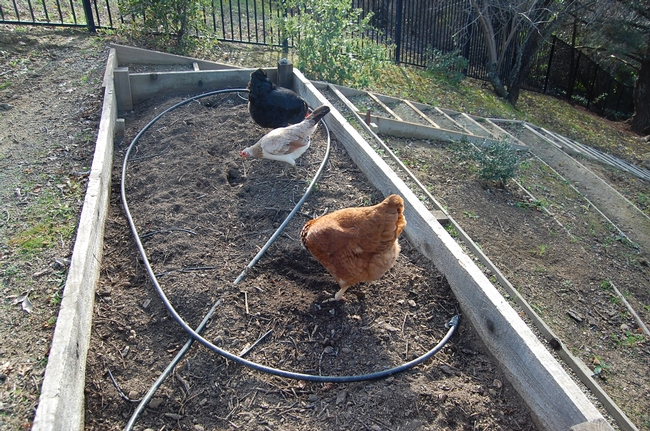
In February, our three hens were welcome to forage in the fallow raised beds. photos by Kathy Thomas-Rico
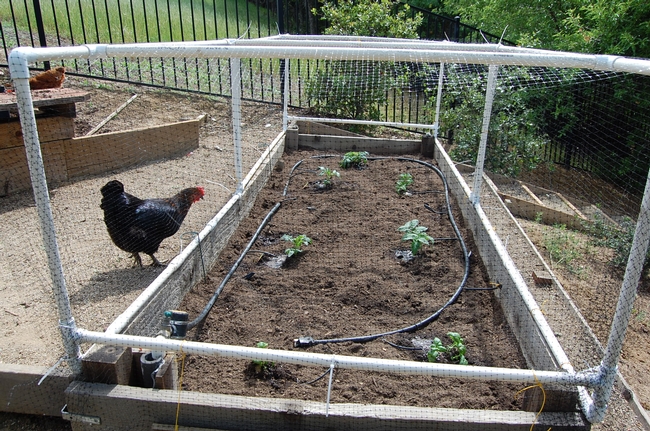
The newly planted bed, with new bird-netting frames, is no longer as welcoming to the hens and local quail.
Don’t flush those fish!
Releasing aquarium fish into local waterways — or down the toilet — can damage aquatic ecosystems in a number of ways. The fish themselves can become an invasive species, they can disrupt habitats for other fish and aquatic species, and they may introduce secondary problems such as harmful pathogens or other aquarium species (seaweed, snails) into the waterways.
At least 13 of the 102 aquarium species that are imported into California have been introduced into California marine waters, according to a recent report by Susan Williams, professor in the Department of Evolution and Ecology at UC Davis and a marine ecologist the Bodega Marine Laboratory. These introduced species have a high success rate (69 percent) in establishing themselves.
Two very invasive species — the predatory lionfish and Caulerpa seaweed (aka “killer algae”) — have reportedly come from the aquarium trade. The lionfish, which has established itself along the East Coast where it eats smaller fish and threatens reef ecological systems, has not yet reached California waters, but the Caulerpa seaweed cost California more than $6 million to eradicate from two Southern California lagoons a decade ago.
At least 34 aquarium species were found to be potential invaders in California marine waters.
“Globally, the aquarium trade has contributed a third of the world’s worst aquatic and invasive species,” Williams said. "Lionfish are voracious predators in their native habitats, and in their invaded habitat any predator is a potential threat to the native ecosystem."
Williams’ advice: "To avoid releasing aquarium species into natural water, don’t dump your aquarium where they can become an expensive and harmful pests.”
She said that people should contact the vendor where the fish was purchased or the California Department of Fish and Wildlife to learn how to dispose of aquarium species responsibly.
Learn more:
- Complete UC Davis news release, by Kat Kerlin
- Our AmazingPlanet report
- Environmental News Network report
- Science on NBC News report
Frost
Frost is water vapor freezing on the surface at a temperature of 32°F or below, forming tiny ice crystals when the water vapor condenses. Frost injury may damage tender plants but not necessarily kill them. A freeze is when surface temperatures of 32°F or colder prevail for days. A hard freeze is 25°F or below and, with both types of freeze, vegetation will be damaged unless protected. Killing freeze depends on hardiness of plants and their exposure. The effects of temperature vary with species, stage of growth, age, general health and water content.
Frost injury occurs when these tiny ice crystals form on the leaf surface, drawing moisture from the leaf tissue. Thus, dehydrated plants are vulnerable. Keep them watered, as water gives off heat. Damp soil retains heat better than dry soil. This protects the roots and warms the air near the soil. Manage your irrigation carefully, keeping the moisture level as even as possible. Do not water more than 3 days in a row. If it has rained recently, you might be okay.
A little protection goes a long way. Place frost sensitive plants in sheltered locations (on a landing, next to a structure, on a bench against the house on the south side). Ground level temperature is colder than the air temperature. Western and southern exposures tend to be warmest. Block walls, rocks and patios collect and reflect the heat of the sun. Although full sun is warmer than shaded locations, night and early morning temperatures cause most frost damage (daybreak is the coldest).
DO NOT prune/cut back anything until the danger of frost has passed. The damage might ultimately reach the roots of the plant--not good. The frost damaged stems and leaves of the Canna and other plants in these photos will continue to help trap warm air. The damage may look bad, but new growth may come out of tissue that might, to you, appear dead. Do not prune frost damaged plants until they begin showing new growth in the spring.
To protect your plants, you need to understand: cold weather, how plants respond to cold, how heat is transferred, how to prevent frost damage, how to care for plants that have been damaged by frost. Review these subjects in AZ 1002 Frost Protection at http://ag.arizona.edu/pubs/garden/az1002.pdf
For citrus and other subtropicals, you can run a sprinkler system slowly or furrow-irrigation through the night. They may need some form of coverage. Take steps to protect them. Then, if they are damaged, steps can be taken to aid recovery. See publication 8100 http://anrcatalog.ucdavis.edu/pdf/8100.pdf
Bring your Medicinal Aloe indoors and consider doing the same with other succulents.
Here are some other sites you might check out:
http://ucanr.org/sites/sacmg/Frost_Protection/
http://ucanr.edu/sites/MarinMG/Marin_Master_Gardener_Help_Desk/Leaflet/How_to_protect_plants_from_frost/
http://cesolano.ucanr.edu/newsletters/Winter_200927313.pdf
http://aggie-horticulture.tamu.edu/travis/docs/FrostsandFreezes.pdf
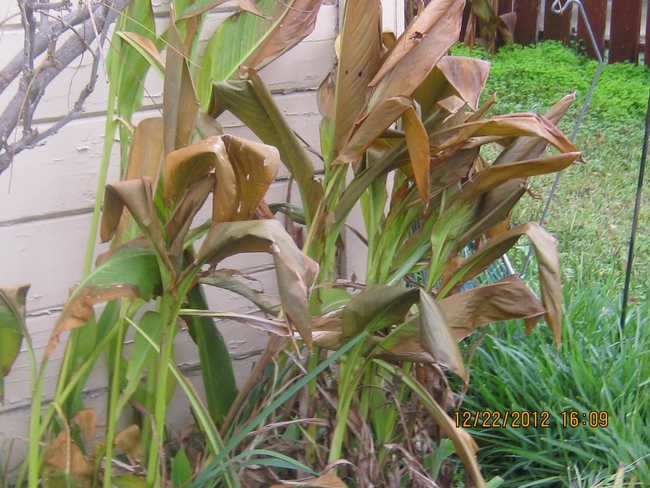
frost on canna yellow
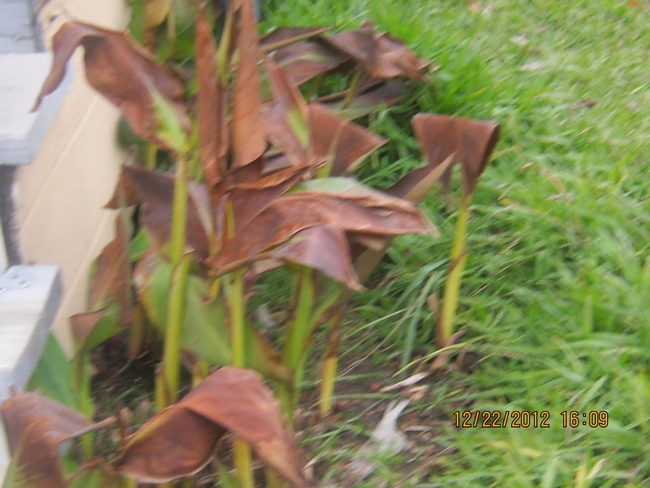
frost damage on canna red
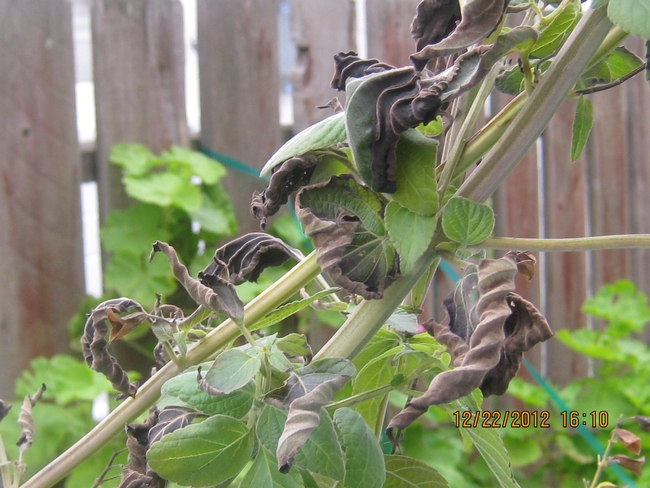
frost damage on mexican sage
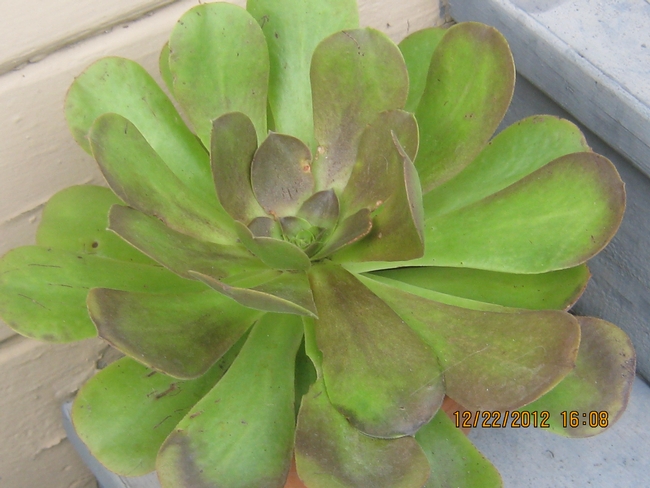
frost on succulent
Plan B for Tropicals
Last year, I bought a pop up greenhouse. I set it up in a sunny place, applied shade cover, and nurtured my tropicals and seedlings. The whole thing was a success. Until winter. At that point, it was basically just a cold frame. While it protected from frost, it was too cold to keep tropicals in there, so they had to come inside.
This spring I noticed the Velcro ties and screen mesh that served as doors dissolved to powder, followed by the roof ripping apart right down the middle of the rip stop material. Long story short, never buy these. It's just land fill. Buy something solid if you must have a greenhouse. Or, you can do what I did. I have a guest room that serves now as a grow room. For a fraction of the cost it takes to buy and set up and run a greenhouse, you can just get the T5 high output fluorescent bulb kits. They are amazing. Alternate the bulbs color spectrum, and your tropicals will bloom as well. They're doing better now than they ever did in that greenhouse.


